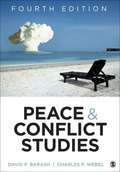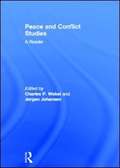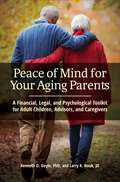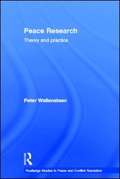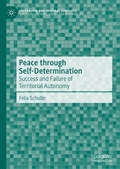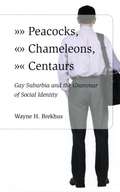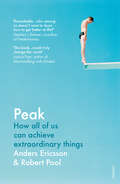- Table View
- List View
Peace and Conflict Studies (PDF)
by David P. Barash Charles P. WebelPeace and Conflict Studies sets the standard for an accessible introduction and comprehensive exploration of this vital subject. The authors share their vast knowledge and analysis of 21st-century world events - including chapters on research methods and democracy, as well as timely topics such as nuclear proliferation; models of conflict analysis, outcomes, and solutions; the Non-Proliferation Treaty; the rise of the BRICs countries; and much more. The text, authored by David Barash and Charles Webel, examines current conflicts, including the latest developments in Iran and North Korea, explores the important aspects of positive peace, individual violence, nationalism, and terrorism, provides numerous visual aids, questions for further study, and suggested readings, and furnishes a comprehensive range of material to enlighten and enrich future discussion and encourage further academic pursuit. With an broad and authoritative scope, this introductory text chronicles a plethora of important global topics from pre-history to the present.
Peace And Conflict Studies: A Reader (PDF)
by Charles Webel Jorgen JohansenPeace and Conflict Studies: A Reader is a comprehensive and intensive introduction to the key works in this growing field. Presenting a range of theories, methodologies, and approaches to understanding peace and to transforming conflict, this edited volume contains both classic and cutting-edge contemporary analyses. The text is divided into six general sections: PART I: Peace Studies, Peace Education, and Peace PART II: Peace Theories and Peace Movements PART III: The Meanings and Nature of Conflict PART IV: Conflict Analysis, Transformation, and Prevention PART V: Nonviolent Action and Political Change. PART VI: Building Institutions and Cultures of Peace With an extensive introduction, as well as recommendations for further reading and questions for the classroom, Peace and Conflict Studies: A Reader will be essential reading for students, teachers, and practitioners of peace and conflict studies, and conflict resolution. It is also highly recommended for students of peace operations, peacebuilding, sociology, international security and IR in general.
Peace as Liberation: Visions and Praxis from Below (Peace Psychology Book Series)
by Fatima Waqi SajjadThis edited volume highlights a type of violence largely overlooked by peace psychologists; it explores ‘epistemic violence’ which refers to the silencing of the marginalized, racialized and colonized people in the process of knowledge production. This book celebrates the voices and the agency of the subalterns, honoring their visions, testimonies and struggles to push boundaries and create spaces for peace within oppressive environments. “Visions and Praxis from below” refers to peace visions and struggles of the people who live “below the vital ability of shaping the world according to their own vision”. It is a challenge to the hegemonic perspective that ‘credible’ thinking on peace can only be done by the people ‘from above’. This perspective will add to the understanding of not only peace psychologists, but all those who work toward social justice.
Peace-building in Israel and Palestine: Social Psychology and Grassroots Initiatives
by J. ChaitinThis book presents an overview of psycho-social research on the Israeli-Palestinian conflict, presents and analyzes people-to-people activities in the region, and offers new conceptualizations for Israeli-Palestinian co-creation of a grassroots peace and social justice processes.
Peace Building Through Women’s Health: Psychoanalytic, Sociopsychological, and Community Perspectives on the Israeli-Palestinian Conflict (Psychoanalytic Inquiry Book Series)
by Norbert GoldfieldThis book is an examination of the Israeli-Palestinian conflict through psychoanalytic, sociopsychological, and nationalistic lenses, highlighting the successes and the hurdles faced by one organization, Healing Across the Divides (HATD), in its mission to measurably improve health in marginalized populations of both Israelis and Palestinians. Peace Building through Women’s Health begins with a summary of the "peace building through health" field and a psychoanalytic, sociopsychological examination of the Israeli-Palestinian conflict. After a series of informative case studies, the book concludes with an analysis of how this organization has evolved its "peace building through health" approach over the fifteen years since its founding. Working with community groups, HATD has measurably improved the lives of more than 200,000 marginalized Israelis and Palestinians. In the process, it also improves the effectiveness of the community group grantees, by offering experienced management consulting and by requiring rigorous ongoing self-assessment on the part of the groups. IHATD hopes that, in the long term, some of the community leaders it supports will be tomorrow’s political leaders. As these leaders strengthen their own capabilities, they will be able to increasingly contribute to securing peace in one of the longest running conflicts in the world today. Peace Building through Women’s Health will be invaluable to public and mental health professionals interested in international health, peace and conflict studies, and conflict resolution.
Peace Building Through Women’s Health: Psychoanalytic, Sociopsychological, and Community Perspectives on the Israeli-Palestinian Conflict (Psychoanalytic Inquiry Book Series)
by Norbert GoldfieldThis book is an examination of the Israeli-Palestinian conflict through psychoanalytic, sociopsychological, and nationalistic lenses, highlighting the successes and the hurdles faced by one organization, Healing Across the Divides (HATD), in its mission to measurably improve health in marginalized populations of both Israelis and Palestinians. Peace Building through Women’s Health begins with a summary of the "peace building through health" field and a psychoanalytic, sociopsychological examination of the Israeli-Palestinian conflict. After a series of informative case studies, the book concludes with an analysis of how this organization has evolved its "peace building through health" approach over the fifteen years since its founding. Working with community groups, HATD has measurably improved the lives of more than 200,000 marginalized Israelis and Palestinians. In the process, it also improves the effectiveness of the community group grantees, by offering experienced management consulting and by requiring rigorous ongoing self-assessment on the part of the groups. IHATD hopes that, in the long term, some of the community leaders it supports will be tomorrow’s political leaders. As these leaders strengthen their own capabilities, they will be able to increasingly contribute to securing peace in one of the longest running conflicts in the world today. Peace Building through Women’s Health will be invaluable to public and mental health professionals interested in international health, peace and conflict studies, and conflict resolution.
Peace of Mind for Your Aging Parents: A Financial, Legal, and Psychological Toolkit for Adult Children, Advisors, and Caregivers
by Kenneth O. Ph.D. Larry K. JDExplains the most effective ways to discuss the legal and financial responsibilities that come with the end of life and tools for managing them—such as wills, trusts, estate planning, and cash management—in the context of financial psychology.Dying is complicated. It presents myriad challenges at a time when people are least prepared to deal with complexity. Typically, aging people turn to their adult children and grandchildren, their caregivers, and their professional advisors to guide them in their final years.This book is aimed directly at the children and grandchildren of aging parents to prepare them for meaningful conversations with their parents and among themselves. It gives them the tools they need to communicate knowledgeably with caregivers and professional advisors and to make important decisions with, or on behalf of, those who depend on them.The authors provide legal and financial tools and techniques, including wills and trusts, cash management, and investment planning, approaching each from both a financial and a psychological perspective. They recognize that some of the challenges that people face during their last few years of life cannot be controlled and describe not only what these tools and techniques can do but also what they can't. Those that cannot be controlled, however, can still be managed, and the authors explain with clarity and compassion how to deal with them through psychological and spiritual engagement.
Peace of Mind for Your Aging Parents: A Financial, Legal, and Psychological Toolkit for Adult Children, Advisors, and Caregivers
by Kenneth O. Ph.D. Larry K. JDExplains the most effective ways to discuss the legal and financial responsibilities that come with the end of life and tools for managing them—such as wills, trusts, estate planning, and cash management—in the context of financial psychology.Dying is complicated. It presents myriad challenges at a time when people are least prepared to deal with complexity. Typically, aging people turn to their adult children and grandchildren, their caregivers, and their professional advisors to guide them in their final years.This book is aimed directly at the children and grandchildren of aging parents to prepare them for meaningful conversations with their parents and among themselves. It gives them the tools they need to communicate knowledgeably with caregivers and professional advisors and to make important decisions with, or on behalf of, those who depend on them.The authors provide legal and financial tools and techniques, including wills and trusts, cash management, and investment planning, approaching each from both a financial and a psychological perspective. They recognize that some of the challenges that people face during their last few years of life cannot be controlled and describe not only what these tools and techniques can do but also what they can't. Those that cannot be controlled, however, can still be managed, and the authors explain with clarity and compassion how to deal with them through psychological and spiritual engagement.
Peace Psychology and Character Strengths: Integrating Science and Practice (Peace Psychology Book Series)
by Ryan M. NiemiecIn this volume the sciences of peace psychology and character strengths integrate in a substantive way to examine how the positive parts of our personality can contribute and impact each “level” of peace - inner, relational, group, community, international, and ecological peace. Readers will discover a wide range of insights, models, and scholarship; new studies conducted for this volume; and practical strategies to bring greater peace to oneself, one’s relationships, and the world.
Peace Psychology in Asia (Peace Psychology Book Series)
by Noraini M. Noor Cristina Jayme MontielIn recent years, peace psychology has grown from a utopian idea to a means of transforming societies worldwide. Yet at the same time peacebuilding enjoys global appeal, the diversity of nations and regions demands interventions reflecting local cultures and realities. Peace Psychology in Asia shows this process in action, emphasizing concepts and methods diverging from those common to the US and Europe. Using examples from China, India, Indonesia, the Philippines, and elsewhere in the region, chapter authors illuminate the complex social, political, and religious conditions that have fostered war, colonialism, dictatorships, and ethnic strife, and the equally intricate personal and collective psychologies that need to be developed to encourage reconciliation, forgiveness, justice, and community. Peace Psychology in Asia: Integrates psychology, history, political science, and local culture into concepts of peace and reconciliation. Highlights the indigenous aspects of peace psychology. Explains the critical relevance of local culture and history in peace work. Blends innovative theoretical material with empirical evidence supporting peace interventions. Balances its coverage among local, national, regional, and global contexts. Analyzes the potential of Asia as a model for world peace. As practice-driven as it is intellectually stimulating, Peace Psychology in Asia is vital reading for social and community psychologists, policy analysts, and researchers in psychology and sociology and international studies, including those looking to the region for ideas on peace work in non-Western countries.
Peace Psychology in Australia (Peace Psychology Book Series)
by Diane Bretherton and Nikola BalvinThis book is a case study of the development of peace psychology in Australia. While there is, in comparison to other countries, relatively little overt violence, Australia the nation was founded on the dispossession of Indigenous people, and their oppression continues today. Peace Psychology in Australia covers the most significant issues of peace and conflict in the country. It begins with a review of conflict resolution practices among Australia’s ancient Indigenous cultures and succinctly captures topics of peace and conflict which the country has faced in the past 222 years since British settlement. The fast population growth, thriving multiculturalism, leadership in international affairs and environmental isolation make Australia a microcosm for the study of human conflicts and peace movements.
Peace Psychology in Germany: A Special Issue of Peace and Conflict
by Klaus Boehnke Daniel Fuss Angela KindervaterFirst published in 2005. This is a special issue of Peace and Conflict, the Journal of Peace Psychology, Volume II, number 3 looks at Peace Psychology in Germany. The papers include old and new antisemitic attitudes, human rights, attitudes towards War, refugees, and results from a German Six-Wave, twenty-year study.
Peace Psychology in Germany: A Special Issue of Peace and Conflict
by Klaus Boehnke Daniel Fuss Angela KindervaterFirst published in 2005. This is a special issue of Peace and Conflict, the Journal of Peace Psychology, Volume II, number 3 looks at Peace Psychology in Germany. The papers include old and new antisemitic attitudes, human rights, attitudes towards War, refugees, and results from a German Six-Wave, twenty-year study.
Peace Psychology in the Balkans: Dealing with a Violent Past while Building Peace (Peace Psychology Book Series)
by Olivera Simić, Zala Volčič and Catherine R. PhilpotThe volume covers the development of peace psychology in the Balkans. The Balkans is a region marked by post-communist and post-conflict transitional turmoil, and this book provides a comprehensive introduction to research in peace psychology in this part of the world, written by scholars primarily working in the Balkan area. It brings together innovative scholarship that examines interdisciplinary aspects of peace psychology researched and written by scholars from Kosovo, Serbia, Bosnia, Bulgaria, Romania, Macedonia, Croatia, and Slovenia as well as presenting research that responds to contemporary global issues by tracking the ways in which peace psychology is developing and implementing in the Balkans.
Peace Research: Theory And Practice (PDF)
by Peter WallensteenComprising essays by Peter Wallensteen, this book presents an overview of the thematic development of peace research, which has become one of the most dynamic and innovative areas of war and conflict studies. Peace research began in the 1950s when centres were formed in the USA and Europe, and today there are research institutes and departments on every continent, with teaching and research programs in most countries, and peace researchers contribute to the development of international studies, development research and security analysis. Prof. Wallensteen has been a witness to much of this since forming the Department of Peace and Conflict Research at Uppsala University in the late 1960s, and this book brings together thirteen of his articles with five new essays in one volume. The book presents articles on such key issues in peace research as the causes of war, conflict data, conflict diplomacy, non-violent sanctions and third- party diplomacy. In this way, it demonstrates how basic research can be conducted in fields often seen as 'unresearchable' and 'too complicated to deal with'. This volume shows that it is a matter of developing definitions, creating valid measures and finding ways of collecting information, recognising that innovations of this kind require supportive research environments. Furthermore, the results are not only useful for the growth of research activity itself, but for finding ways of dealing with actual conflicts. Thus, attention is also paid here to conflict prevention, peace agreements, sanctions and third-party activity for preventing and ending armed conflict, and building a lasting post-war peace. This book will be of great interest to all students of peace studies, conflict resolution, war and conflict studies, development studies and IR/security studies in general.
Peace Research: Theory And Practice
by Peter WallensteenComprising essays by Peter Wallensteen, this book presents an overview of the thematic development of peace research, which has become one of the most dynamic and innovative areas of war and conflict studies. Peace research began in the 1950s when centres were formed in the USA and Europe, and today there are research institutes and departments on every continent, with teaching and research programs in most countries, and peace researchers contribute to the development of international studies, development research and security analysis. Prof. Wallensteen has been a witness to much of this since forming the Department of Peace and Conflict Research at Uppsala University in the late 1960s, and this book brings together thirteen of his articles with five new essays in one volume. The book presents articles on such key issues in peace research as the causes of war, conflict data, conflict diplomacy, non-violent sanctions and third- party diplomacy. In this way, it demonstrates how basic research can be conducted in fields often seen as 'unresearchable' and 'too complicated to deal with'. This volume shows that it is a matter of developing definitions, creating valid measures and finding ways of collecting information, recognising that innovations of this kind require supportive research environments. Furthermore, the results are not only useful for the growth of research activity itself, but for finding ways of dealing with actual conflicts. Thus, attention is also paid here to conflict prevention, peace agreements, sanctions and third-party activity for preventing and ending armed conflict, and building a lasting post-war peace. This book will be of great interest to all students of peace studies, conflict resolution, war and conflict studies, development studies and IR/security studies in general.
Peace through Self-Determination: Success and Failure of Territorial Autonomy (Federalism and Internal Conflicts)
by Felix SchulteBringing together comparative politics, conflict research and social psychology, this book presents a novel theory to explain the consolidation outcomes of post-conflict autonomy arrangements. It builds on Social Identity Theory and identifies a successful process of ethnic recognition as the key prerequisite for peaceful interethnic cohabitation through territorial self-governance. As this process is highly context-dependent, the study identifies relevant structural and actor-centered factors and analyzes their occurrence in the consolidation periods of nineteen autonomy arrangements worldwide using Qualitative Comparative Analysis (QCA). The author concludes that elites accept autonomy reforms if they promise a high degree of self-determination and, at the same time, ethnic recognition is not hindered by horizontal inequalities. Bargaining efforts succeed within inclusive institutions involving non-nationalist parties and international organizations. Autonomy reforms fail if the degree of self-rule offered is too low and strong inequalities generate new grievances. Autocratic rule, nationalist parties, and a lack of international attention provide a breeding ground for further centrifugal activities. In-depth case studies on South Tyrol and the Chittagong Hill Tracts provide further evidence for the theoretical models.
Peace, War, and Mental Health: Couples Therapists Look at the Dynamics
by Barbara Jo BrothersDiscover how issues of world war and peace relate to the dynamics of couples therapy in this thought-provoking book. In Peace, War, and Mental Health, couples therapists provide diverse views on the links between strengthening marriages and preventing and solving international disputes. Although the contributors vary in their approaches to this issue, a common theme is the belief that couples as well as countries need to build bridges, not walls, for healthy relationships and they need to strive to learn what others are really feeling, thinking, or needing underneath the defenses others exhibit.The contributing therapists in Peace, War, and Mental Health explore the various links between couples in conflict and nations at war. Chapters describe how prevention strategies used for couples in therapy may be applied to the well-being of the world as a whole and how significant change is possible through the involvement of only a small percentage of the population. Other chapters focus on specific tools for couples therapy such as outlines of the major tasks of relationship building and traps that mitigate against good relationship construction, a description of the nuts and bolts of conflict resolution, and the use of flashcards to help both members of the pair present his or her real feelings to the other. Some of the intriguing topics covered in this book include: the relationship between psychotherapy and spirituality and the paradox of individuals longing to belong since each is a part of the whole the role of gender on war and its potential impact on peace the failure of the humanistic movement societal attitudes linking domestic violence and large scale violence how the potential for resolution of differences in couples can be applied to peace among nations how prevention may be expanded to include the “mental health” of the whole world--Part V of an interview with Virginia SatirPeace, War, and Mental Health helps therapists look at international peace and couples therapy with new perspectives, a necessity in today’s rapidly changing family and world climate.
Peace, War, and Mental Health: Couples Therapists Look at the Dynamics
by Barbara Jo BrothersDiscover how issues of world war and peace relate to the dynamics of couples therapy in this thought-provoking book. In Peace, War, and Mental Health, couples therapists provide diverse views on the links between strengthening marriages and preventing and solving international disputes. Although the contributors vary in their approaches to this issue, a common theme is the belief that couples as well as countries need to build bridges, not walls, for healthy relationships and they need to strive to learn what others are really feeling, thinking, or needing underneath the defenses others exhibit.The contributing therapists in Peace, War, and Mental Health explore the various links between couples in conflict and nations at war. Chapters describe how prevention strategies used for couples in therapy may be applied to the well-being of the world as a whole and how significant change is possible through the involvement of only a small percentage of the population. Other chapters focus on specific tools for couples therapy such as outlines of the major tasks of relationship building and traps that mitigate against good relationship construction, a description of the nuts and bolts of conflict resolution, and the use of flashcards to help both members of the pair present his or her real feelings to the other. Some of the intriguing topics covered in this book include: the relationship between psychotherapy and spirituality and the paradox of individuals longing to belong since each is a part of the whole the role of gender on war and its potential impact on peace the failure of the humanistic movement societal attitudes linking domestic violence and large scale violence how the potential for resolution of differences in couples can be applied to peace among nations how prevention may be expanded to include the “mental health” of the whole world--Part V of an interview with Virginia SatirPeace, War, and Mental Health helps therapists look at international peace and couples therapy with new perspectives, a necessity in today’s rapidly changing family and world climate.
Peacebuilding Online: Dialogue and Enabling Positive Peace
by Rachel Nolte-LairdThis study takes the work of transforming violence and conflict online and offers insight into the practice of dialogue in virtual settings for peacebuilding purposes. In the field of peace and conflict studies and peacebuilding practices, a significant amount of literature has dealt with the theory and practice of dialogue in face-to-face settings. This project is unique as it takes the peacebuilding practice of dialogue and explores it within an online context. The research is framed and analyzed through the dialogue theories of Martin Buber and Paulo Freire. This project is distinct in its exploration of the connection between dialogue encounters and positive peace, the practical linkages of which are often difficult to articulate or identify. As such, this book offers unique contributions to the knowledge and understanding of dialogue-based peacebuilding in online settings and provides an understanding of how dialogue practices enable outcomes within the construct of positive peace. This book is aimed at academics as a presentation of research into a relatively unexplored field of inquiry. However, it is also relevant and applicable for peacebuilding practitioners who want to navigate taking their practices into online settings and provide a framework for linking practices to intended positive peace outcomes.
Peaceful Breeze
by Mark CarringtonCaring for someone you love who is suffering from a terminal illness can be one of the greatest honours in life. Helping a loved one to die with peace, grace and dignity is their human right and a privilege for their carer to enable. It can be a truly transformative experience. In Peaceful Breeze Mark Carrington shares his searingly honest account of nursing his much-loved mother after she was diagnosed with bowel cancer in 2014. As his mum’s son, carer and advocate, Mark felt alone and under tremendous pressure to look after her the best he could; at the time, he wished that there was a practical guide to support him as he was supporting his mum. Peaceful Breeze is Mark’s profound journey through terminal illness; from his mum’s initial diagnoses, through her valiant fight, to her ultimate passing. He charts the emotional turmoil - from complete despair to moments of joy with his mum that will live on forever - the stress, the difficult decisions he had to make and finally the all-consuming grief he experienced at her loss. Mark Carrington story is one of bravery, devotion, love and hope, one which he hopes will support and inform other carers as they nurse and cherish their own family and friends.
Peacocks, Chameleons, Centaurs: Gay Suburbia and the Grammar of Social Identity
by Wayne BrekhusWhat does it mean to be a gay man living in the suburbs? Do you identify primarily as gay, or suburban, or some combination of the two? For that matter, how does anyone decide what his or her identity is? In this first-ever ethnography of American gay suburbanites, Wayne H. Brekhus demonstrates that who one is depends at least in part on where and when one is. For many urban gay men, being homosexual is key to their identity because they live, work, and socialize in almost exclusively gay circles. Brekhus calls such men "lifestylers" or peacocks. Chameleons or "commuters," on the other hand, live and work in conventional suburban settings, but lead intense gay social and sexual lives outside the suburbs. Centaurs, meanwhile, or "integrators," mix typical suburban jobs and homes with low-key gay social and sexual activities. In other words, lifestylers see homosexuality as something you are, commuters as something you do, and integrators as part of yourself. Ultimately, Brekhus shows that lifestyling, commuting, and integrating embody competing identity strategies that occur not only among gay men but across a broad range of social categories. What results, then, is an innovative work that will interest sociologists, psychologists, anthropologists, and students of gay culture.
Peacocks, Chameleons, Centaurs: Gay Suburbia and the Grammar of Social Identity
by Wayne BrekhusWhat does it mean to be a gay man living in the suburbs? Do you identify primarily as gay, or suburban, or some combination of the two? For that matter, how does anyone decide what his or her identity is? In this first-ever ethnography of American gay suburbanites, Wayne H. Brekhus demonstrates that who one is depends at least in part on where and when one is. For many urban gay men, being homosexual is key to their identity because they live, work, and socialize in almost exclusively gay circles. Brekhus calls such men "lifestylers" or peacocks. Chameleons or "commuters," on the other hand, live and work in conventional suburban settings, but lead intense gay social and sexual lives outside the suburbs. Centaurs, meanwhile, or "integrators," mix typical suburban jobs and homes with low-key gay social and sexual activities. In other words, lifestylers see homosexuality as something you are, commuters as something you do, and integrators as part of yourself. Ultimately, Brekhus shows that lifestyling, commuting, and integrating embody competing identity strategies that occur not only among gay men but across a broad range of social categories. What results, then, is an innovative work that will interest sociologists, psychologists, anthropologists, and students of gay culture.
Peacocks, Chameleons, Centaurs: Gay Suburbia and the Grammar of Social Identity
by Wayne BrekhusWhat does it mean to be a gay man living in the suburbs? Do you identify primarily as gay, or suburban, or some combination of the two? For that matter, how does anyone decide what his or her identity is? In this first-ever ethnography of American gay suburbanites, Wayne H. Brekhus demonstrates that who one is depends at least in part on where and when one is. For many urban gay men, being homosexual is key to their identity because they live, work, and socialize in almost exclusively gay circles. Brekhus calls such men "lifestylers" or peacocks. Chameleons or "commuters," on the other hand, live and work in conventional suburban settings, but lead intense gay social and sexual lives outside the suburbs. Centaurs, meanwhile, or "integrators," mix typical suburban jobs and homes with low-key gay social and sexual activities. In other words, lifestylers see homosexuality as something you are, commuters as something you do, and integrators as part of yourself. Ultimately, Brekhus shows that lifestyling, commuting, and integrating embody competing identity strategies that occur not only among gay men but across a broad range of social categories. What results, then, is an innovative work that will interest sociologists, psychologists, anthropologists, and students of gay culture.
Peak: How All of Us Can Achieve Extraordinary Things (A\peak Marcello Adventure Ser.)
by Robert Pool Anders EricssonYou don't have to be a genius to achieve extraordinary things.In this fascinating book, Anders Ericsson and Robert Pool explain that learning new skills doesn't need to be daunting. Musical prodigies, sports stars and leading scientists acquire their special abilities through training – and all of us can do the same.Based on thirty years of pioneering research, Peak shows that success simply requires the right kind of practice and offers essential advice on setting goals, receiving guidance and motivating ourselves. The astonishing stories prove that whether we're at work or at school, in the music room or on the sports field, we can master almost anything.'Remarkable...who among us doesn't want to learn how to get better at life?'Stephen J. Dubner, co-author of Freakonomics'This book...could truly change the world'Joshua Foer, author of Moonwalking with Einstein'Groundbreaking...brilliantly useful'Daniel Coyle, author of The Talent Code
